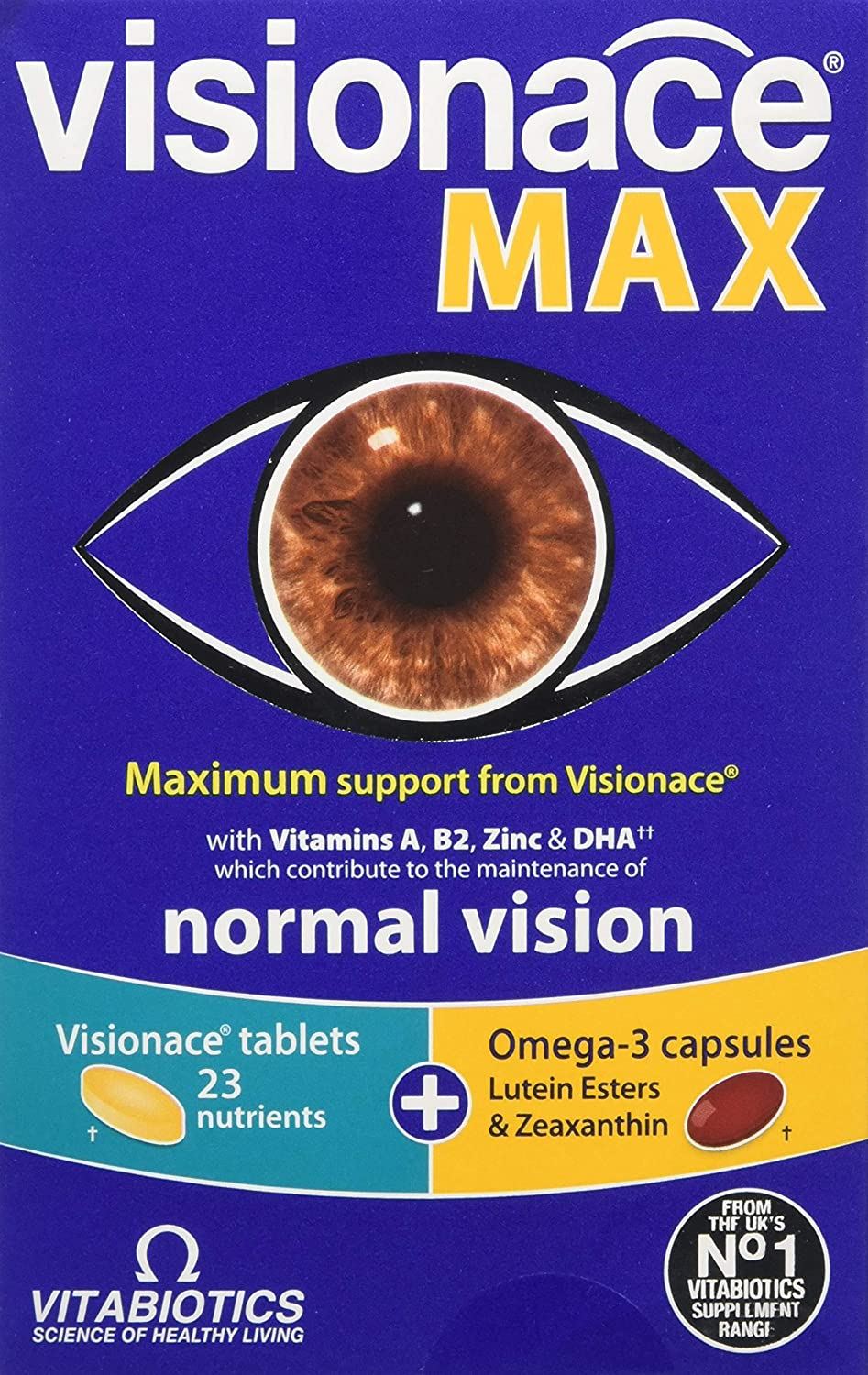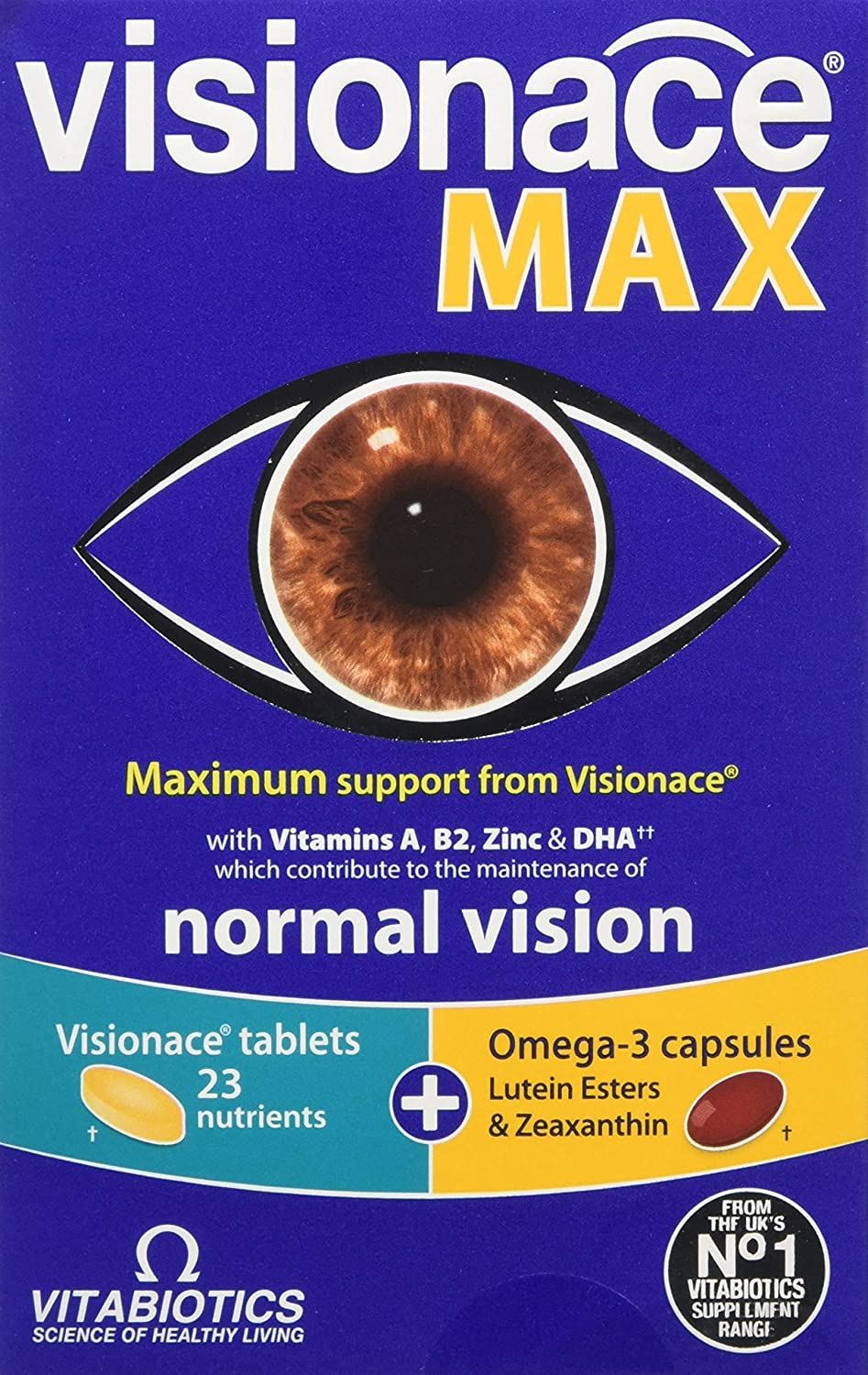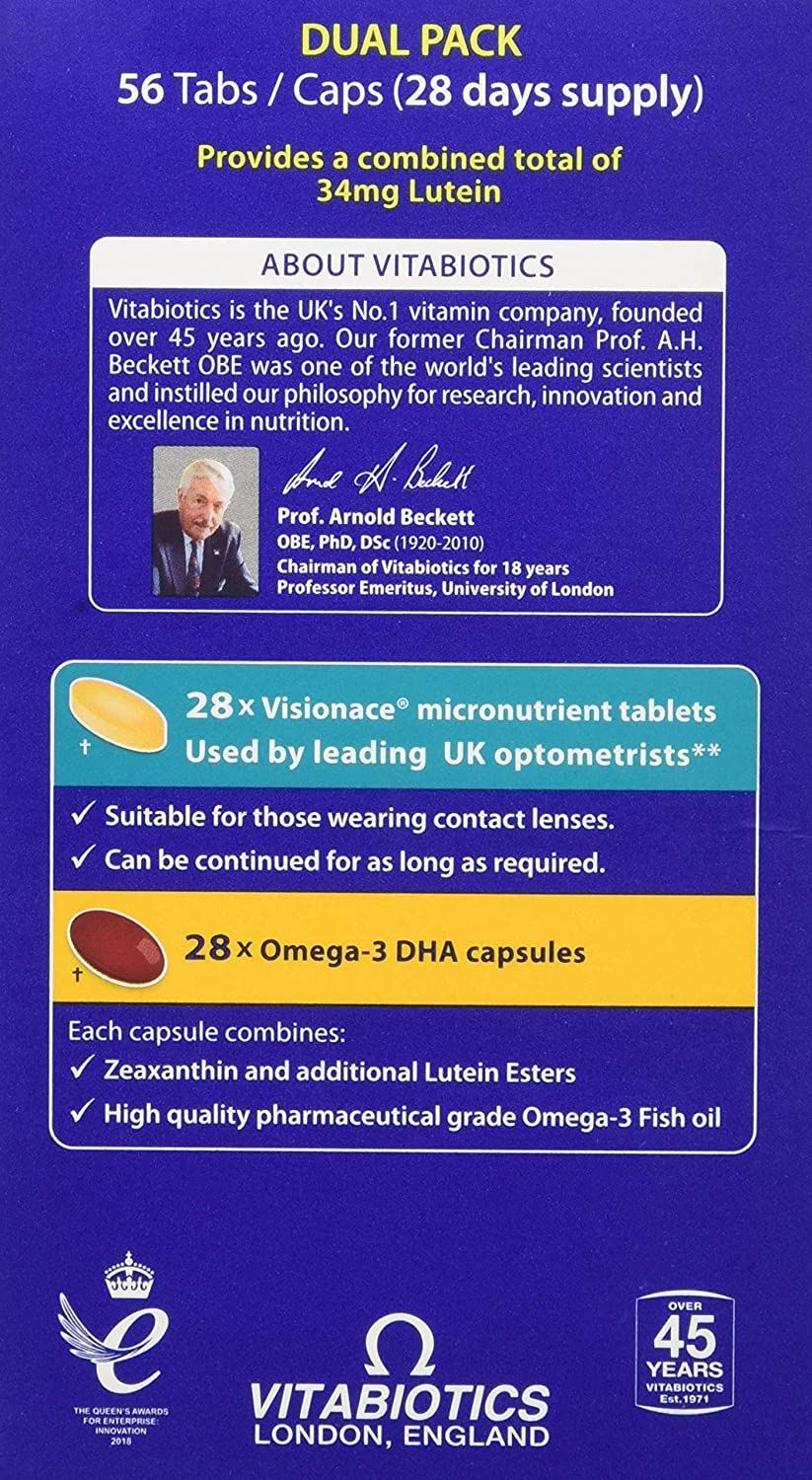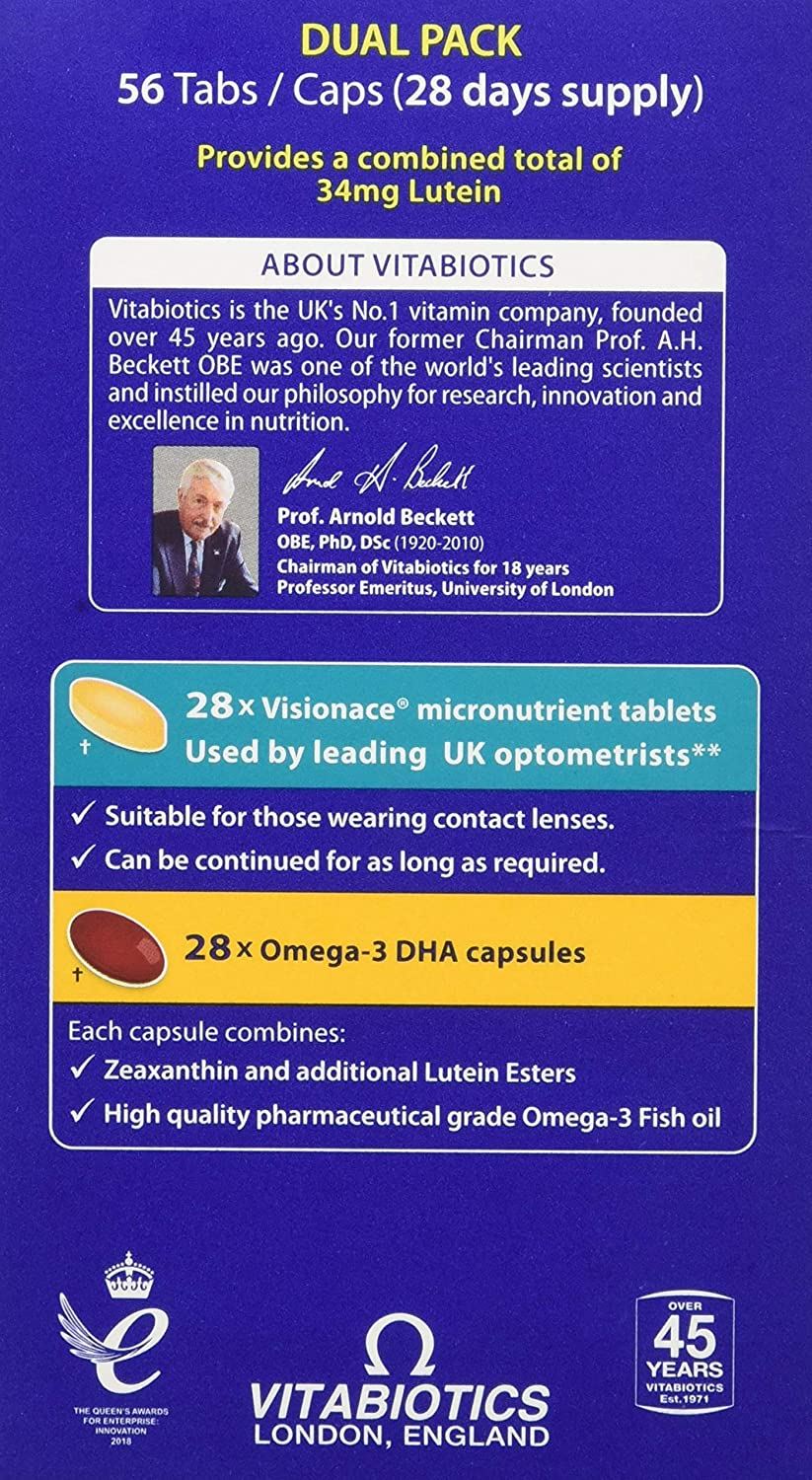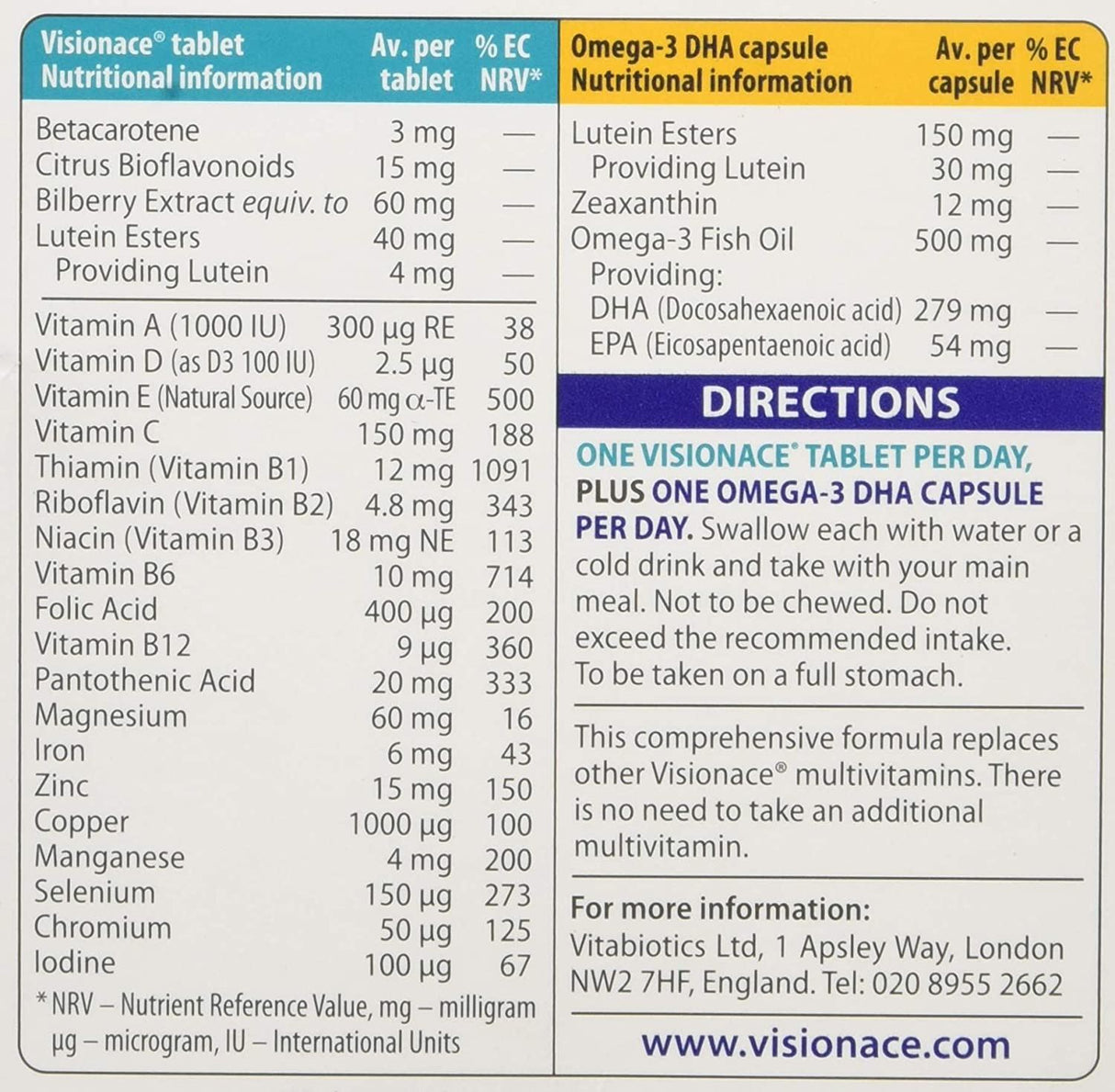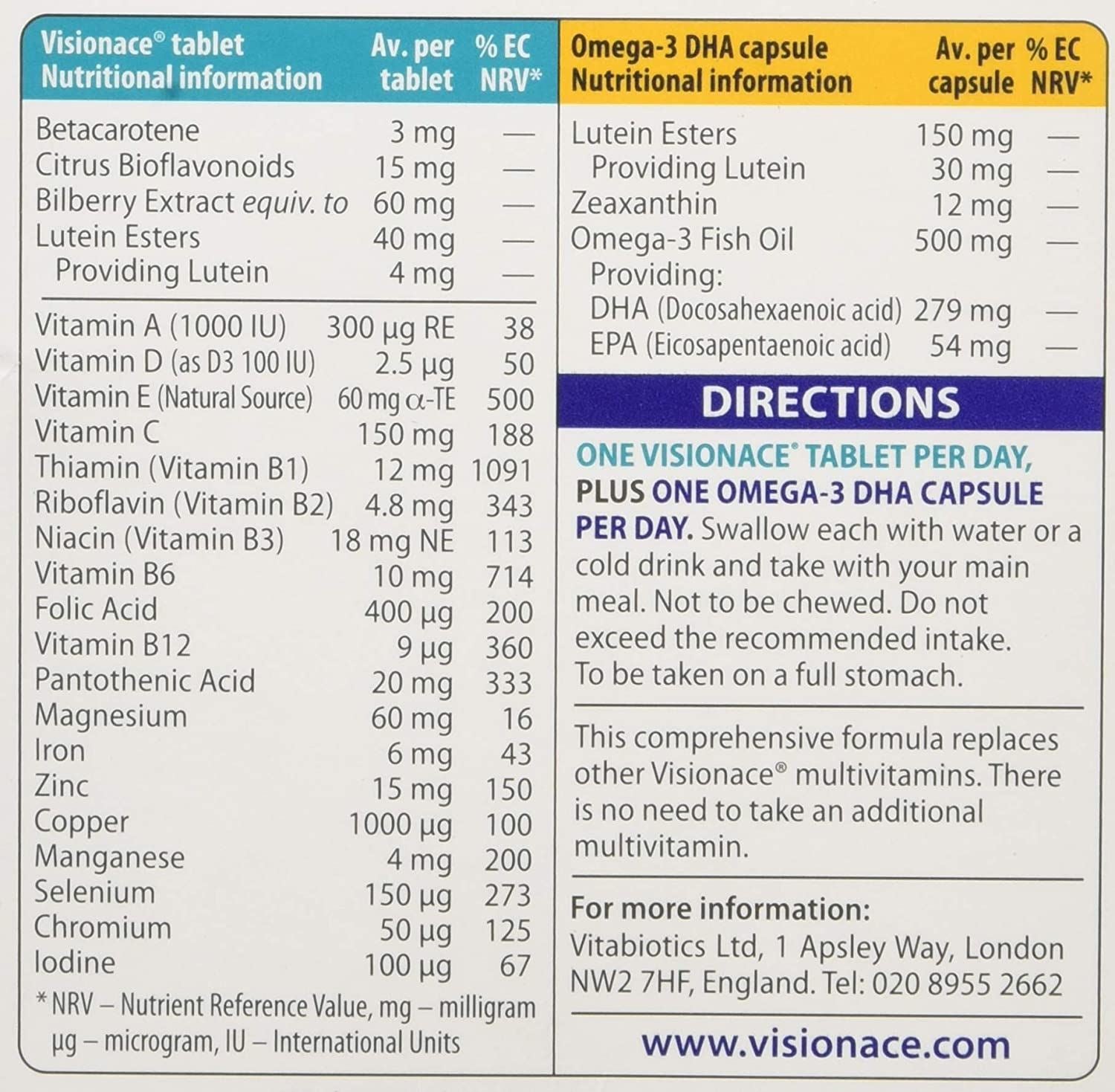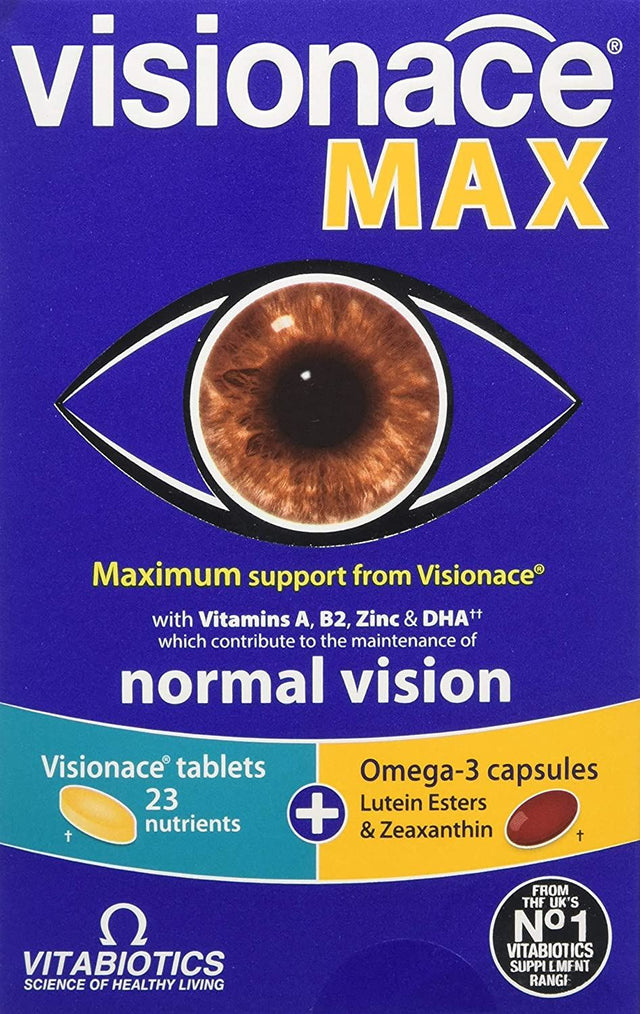Vitabiotics Visionace Max - 28 Tablets + 28 Capsules
Vitabiotics Visionace Max - 28 Tablets + 28 Capsules is backordered and will ship as soon as it is back in stock.
Couldn't load pickup availability
For the maximum nutritional support in Vitabiotics vision range, Visionace Max is a 3-in-1 source of essential nutrients and important Omega-3 DHA fatty acids
- The ultimate level of support in the Visionace range
- Includes Vitamins A, B2, Zinc and DHA which contribute to the maintenance of normal vision1
- Contains extra levels of Zeaxanthin and Lutein Esters, a dominant pigment in the retina
- From the UK's No.1 vitamin company
Vitabiotics Visionace Max
Vitabiotics Visionace Max provides the maximum support in the Visionace range, combining the Visionace Original multinutrient tablets with high quality Omega-3 capsules containing additional Lutein Esters and Zeaxanthin, in a convenient dual pack.
Vitabiotics Visionace tablets include a comprehensive range of micronutrients, including vitamins A, B2 and zinc which contribute to the maintenance of normal vision.
The importance of Omega-3 fatty acids
Omega-3 fatty acids are a special class of polyunsaturated fatty acids which are commonly found in plant seed oils, nut oils and oily fish such as sardines and salmon. A large number of scientific studies worldwide have highlighted the multiple benefits of dietary Omega-3 fatty acids in areas as diverse as heart, brain, and normal vision. The two most researched Omega-3 fatty acids are Docosahexaenoic Acid (DHA) and Eicosapentaenoic acid (EPA). DHA contributes to the maintenance of normal vision1.
The role of DHA in the retina
Omega-3 fatty acids play an important structural and functional role in the retina, the part of the eye that detects light. DHA is a component of photoreceptor cells which are responsible for converting light into nerve signals. Photoreceptors contain the highest concentration of DHA of any cell in the body, with DHA accounting for over 50% of the total fatty acid content2 3. Adequate levels of DHA must be maintained for the retina to continue to function properly and to maintain normal vision)4 5.
The retinal cells are continually being renewed, so a constant supply of Omega-3 fatty acids and in particular DHA is required6 7. Since these cannot be made by the body, a lack of these in the diet can have a direct effect on levels in the retina8. Fortunately increasing dietary intake can help to restore retinal Omega-3 levels9. Omega-3 fatty acids are now being recognised as being essential for normal eye health from before birth continuing into old age10.
Lutein Esters
Lutein makes up the dominant pigment in the retina which absorbs visible blue light. Vitabiotics Visionace Max provides a combined total of 34mg of Lutein Esters.
Zeaxanthin
Zeaxanthin is a structural component of the macular which is the central area of the retina, containing the highest density of photoreceptors.
Zeaxanthin cannot be made in the body, so must come from dietary sources, such as eggs, broccoli and spinach, as well as spirulina which can be added to smoothies.
Protection of cells
The photoreceptors in the retina are particularly vulnerable to the effects of UV rays in sunlight which can result in cellular damage11 12. Because of this, sunglasses with a high Eye-Sun Protection Factor (E-SPF) are always recommended to reduce the exposure of the eye to excessive light and harmful UV rays.
Vitabiotics Visionace Max provides vitamins C and E, plus zinc and selenium which contribute to the protection of cells from oxidative stress.
Quality and Purity Guaranteed
Only the purest pharmaceutical grade fish oil is used in Vitabiotics Visionace Max. To ensure maximum benefit, the oil is carefully concentrated to increase its DHA and EPA content and further purified. Each batch is rigorously tested, certified, and fully compliant with stringent EC and WHO rules on environmental pollutants.
General health and wellbeing
Vitabiotics Visionace Max is a comprehensive formula that replaces other multivitamin supplements. The formula includes folic acid plus vitamins B12 and B2 which contribute to the reduction of tiredness and fatigue, as well as iron which supports normal oxygen transport in the body and has a role in the process of cell division.
1The beneficial effect is obtained with a daily intake of 250mg of DHA.
2Bazan, N.G. (1990) Nutrition and the Brain, eds. Wurtman, R. J. & Wurtman, J. J. (Raven, New York), Vol. 8: 1-24
3Mukherjee P.K. et al, Proc Natl Acad Sci, 2007, Aug 7;104(32):13152-7
4Weisinger, H.S. et al. Lipids 1996 ; 31,65-70
5Birch E. et al. Invest. Ophthalmol. Vis. Sci 1992; 33 (11): 3242- 3253
6Mukherjee P. K. et al. PNAS 2004; 101(22): 8491 - 8496
7Bazan N.G. & ReddyT.S. (1985) Retina. In Handbook of Neurochemistry, 2nd ed, Vol no 8, New York, Plenum, pg 507
8Acar N. et al Reprod. Nutr.Dev 2006; 46 515-525
9Uauy, R et al Lipids 31(suppl) 1996:167-176
10Cho E. et al. Am J Clin Nutr 2001;73:209-18
11Bazan N.G., Trends Neurosci, 2006 May;29(5):263-71
12Rotstein et al. Invest. Ophthalmol. Vis. Sci 2003; 44 (5): 2252-2259
From the UK's no 1 Vitabiotics supplement range
Provides a combined total of 34mg lutein
The Queen's Awards for Enterprise: Innovation 2018
Quality guaranteed
No artificial colours
No preservatives and yeast
Visionace is not tested on animals
Ingredients
Visionace® Tablet
Vitamin C (Ascorbic Acid, Glyceryl Tristearate), Bulking Agents: Microcrystalline Cellulose & Dibasic Calcium Phosphate, Magnesium Oxide, Vitamin E Natural Source (as D-Alpha Tocopheryl Acid Succinate) (from SOYA), Lutein Esters & Zeaxthanthin Esters (Carriers: Sugar, Natural Vitamin E, Ascorbyl Palmitate, Cellulose Gum), Zinc Sulphate, Tablet Coating (Hydroxypropylmethylcellulose, Hydroxypropylcellulose, Capric/Caprilic Triglycerides, Glycerin, Natural Source Colours [Titanium Dioxide, Iron Oxides]), Pantothenic Acid (as Calcium Salt), Citrus Bioflavonoids, Anti-Caking Agents: Stearic Acid, Magnesium Stearate & Silicon Dioxide, Thiamin (Vitamin B1 as Mononitrate), Niacin (Nicotinamide), Ferrous Fumarate, Betacarotene (Starch, Water, Antioxidant: DL-Alpha Tocopherol), Vitamin B6 (Pyridoxine HCI), Bilberry Extract, Manganese Sulphate, Cross-Linked Cellulose Gum, Riboflavin (Vitamin B2), Hydroxypropylmethylcellulose, Vitamin A (Vitamin A Acetate [Carriers: Acacia, Starch, Maltodextrin, Antioxidant: DL-Alpha Tocopherol]), Copper Sulphate, Vitamin D3 (Cholecalciferol [Carriers: Acacia, Sucrose, Corn Starch, Medium Chain Triglycerides, Antioxidant: DL-Alpha Tocopherol]), Folic Acid (as Pteroylmonoglutamic Acid), Sodium Selenate, Chromium Trichloride, Potassium Iodide, Vitamin B12 (Cyanocobalamin).
Omega-3 DHA capsule
Omega-3 Fish Oil (High DHA Fish Oil) (from FISH), Capsule Shell (Pharmaceutical Grade Gelatin [Halal Bovine Source], Glycerin, Natural Source Colour [Red Iron Oxide]), Lutein Esters (Carriers: Vegetable Oil, Antioxidant: Natural Vitamin E), Zeaxanthin (Carrier: Sunflower Oil).
Allergy Advice: For allergens, see ingredients in bold.
Nutritional Information
Visionace tablet
| Nutritional Information | Average per tablet | % NRV* |
| Betacarotene | 3 mg | -- |
| Citrus Bioflavonoids | 15 mg | -- |
| Bilberry Extract equiv. to | 60 mg | -- |
| Lutein Esters | 40 mg | -- |
| Providing Lutein | 4 mg | |
| Vitamin A (1000 IU) | 300 µg RE | 38 |
| Vitamin D (as D3 100 IU) | 2.5 µg | 50 |
| Vitamin E (Natural Source) | 60 mg α-TE | 500 |
| Vitamin C | 150 mg | 188 |
| Thiamin (Vitamin B1) | 12 mg | 1091 |
| Riboflavin (Vitamin B2) | 4.8 mg | 343 |
| Niacin (Vitamin B3) | 18 mg NE | 113 |
| Vitamin B6 | 10 mg | 714 |
| Folic Acid | 400 µg | 200 |
| Vitamin B12 | 9 µg | 360 |
| Pantothenic Acid | 20 mg | 333 |
| Magnesium | 60 mg | 16 |
| Iron | 6 mg | 43 |
| Zinc | 15 mg | 150 |
| Copper | 1000 µg | 100 |
| Manganese | 4 mg | 200 |
| Selenium | 150 µg | 273 |
| Chromium | 50 µg | 125 |
| Iodine | 100 µg | 67 |
*NRV = Nutrient Reference Value, µg = microgram
mg = milligram, IU = International Units
Directions
One Visionace® tablet per day, plus one Omega-3 DHA capsule per day.
Swallow each with water or a cold drink and take with your main meal.
Not to be chewed.
Do not exceed the recommended intake.
To be taken on a full stomach.
This comprehensive formula replaces other Visionace® multivitamins. There is no need to take an additional multivitamin.
Advisory Information
Food supplements must not replace a varied and balanced diet and a healthy lifestyle.
As with other food supplements, consult your doctor or pharmacist before using if you are under medical supervision, pregnant, breast-feeding, have epilepsy, haemochromatosis, a thyroid condition, suffer from food allergies, or are allergic to any of the ingredients.
Not suitable for children.
Those taking anticoagulants (blood thinners) should consult their doctor before using this product.
This product will not affect the lens prescription required in long and shortsightedness and astigmatism.
Store below 25°C in a dry place out of sight and reach of children.
Not Tested on Animals
Made in a site that may handle Nuts
For allergens, see ingredients in BOLD
Contains: Fish, Soya
Free From: Artificial Colours, Preservatives, Yeast

